There are several types of periodicities in QuantShare. Time driven periodicities include second bars, minute bars, hour bars, daily bars, weekly bars... Price driven periodicities include range bars, change bars, signal change bars, point and figure... Volume driven periodicities include tick, tick bars and volume bars. Besides the build-in periodicities and chart bar types, QuantShare allows you to create custom periodicities. Time Driven Periodicities These types of periodicities create bar at a fixed interval. In a one minute bar, for example, each bar represents the trading activity that occurred during one minute. In a two hours bar, each bar lasts two hours; when the time is exceeded (2 hours), a new bar is created. In an EOD chart, the user can choose between a daily, weekly, monthly, yearly or custom period. To update the time frame of your EOD chart, select the time-frame button (Bottom left corner) then choose the appropriate value. To set a specific number of days as time frame, open the latter menu then select "custom". In an intraday chart, the user can choose between one tick, one second, one minute, 5 minutes, 10 minutes, 15 minutes, 30 minutes, 1 hour, 2 hours, 5 hours or custom period. To update the intraday time frame, click on the appropriate button (Bottom left corner) then choose a time frame. To set a specific number of seconds as time frame, open the latter menu then select "custom I". Here, time period for each bar is constant and the date represents the start of the period. 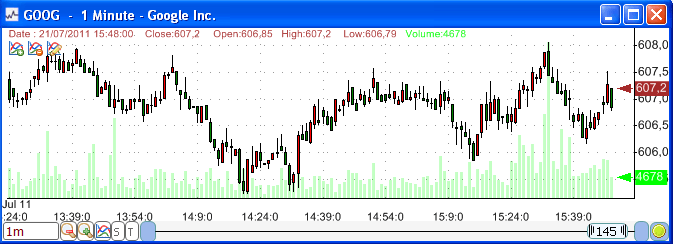 Price Driven Periodicities In a price driven periodicity, a new bar is created based on price movements. Time period for each bar is not constant and it depends on the price rule behind the periodicity. For example, in a range bar periodicity, a new bar is created when a price range is broken. If we take a $1 range bar, then each bar should measure $1 (measured from high to low), when the current bar exceeds 1$, a new bar is created. You can choose to work with normal units or with tick size multiple units. Here is how to create price driven periodicities: - Right click on a pane - Select "Periodicity" or/then "Periodicity Settings" - Click on "Add new periodicity", type a name then click on "Save Item" - Select your item then update the variable in the "Periodicity" panel. Here are some other price driven periodicities: Change Bars: A change bar is based on a security return. A new bar is created when the sum of one-bar rate of return becomes higher or equal to a specific value. Example: In a 5-Change periodicity, each bar represents a change of 5% in the price of the asset. This is the default implementation; you can update it by changing the rule next to "Formula" field. Signal Change Bars: A signal change bar is based on a signal or rule. A new bar is created when the rule becomes TRUE. Example: In a (Close > Open) signal change chart, a new bar is created when the close price becomes higher than the open price. As with "Change Bars", the formula of this periodicity is customizable. 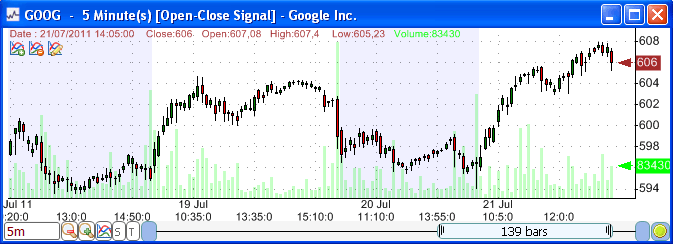 Point and Figure: This bar type is based solely on prices (no time or volume). It is a special type, because it has a custom chart style (different from Bar Chart or Japanese Candlesticks). Each column is constituted of different boxes. An "X" box represents rising price, while a "0" box represents falling price. A new box is created when price moves more than the box size. To create a point and figure chart: - Right click on a chart - Select "Chart Type" - select "Point & Figure" Box size as well as other settings can be updated by right clicking on a chart, selecting "Chart Type" then "Chart Type Settings". Alternatively, you can also update these settings by selecting "View" in the main menu then "Chart Style". 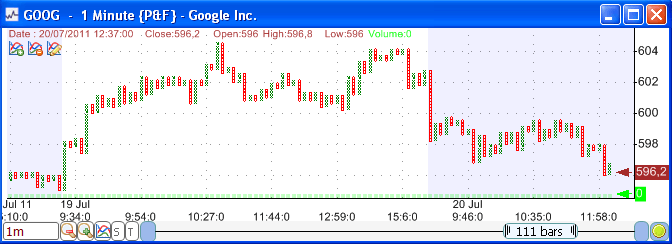 Kagi: Kagi is also a special type of periodicity. It plots a bar in the direction of price until price reverses and exceeds a specific amount named Reversal. 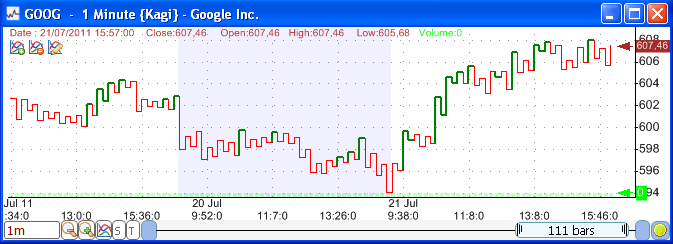 Heikin Ashi: It is a weighted version of candlesticks. The open, high, low and close prices are calculated based on specific formula. Volume Driven Periodicities The last type of periodicities uses volume in order to generate new bars. Tick: In a tick chart, each point represents one trade (tick). To create a tick chart, right click on a chart, select "Chart Timeframe" then click on "Ticks". Tick Bars: A tick bars is based on a specific number of trades or ticks. A new bar is created when the specified number of ticks is reached. Example: In a 20-tick periodicity, each bar represents 20 ticks or trades. Volume Bars: Volume bars are based on a specific number of traded shares. Example: In a 20.000-volume periodicity, each bar contains transactions that represent a volume of 20.000 shares. 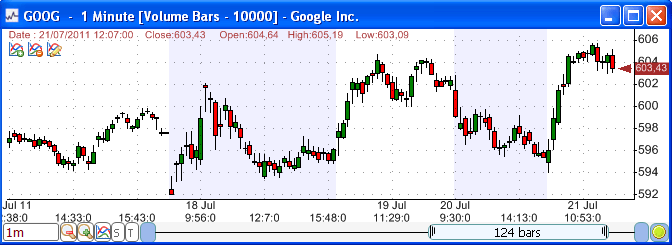 Mixed Periodicities The price driven periodicity will calculate bars based on a time-series that is obtained from a time driven periodicity. Example: Signal Change Bars based on 5-minutes period will generate completely different results that a Signal Change Bars based on 10-minutes period. If you create a chart with a price driven periodicity, you will see for example (at the top): A - Daily [Range Bars]
|

|
|
|
|







